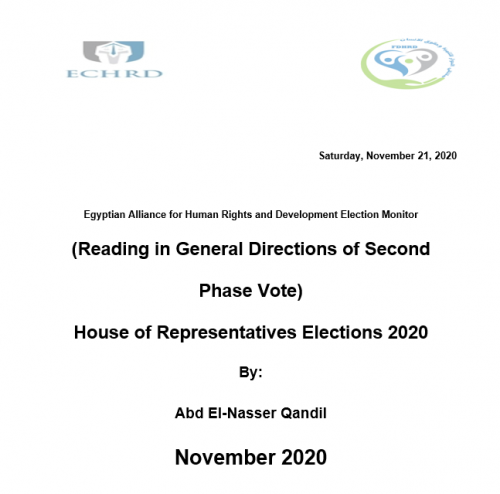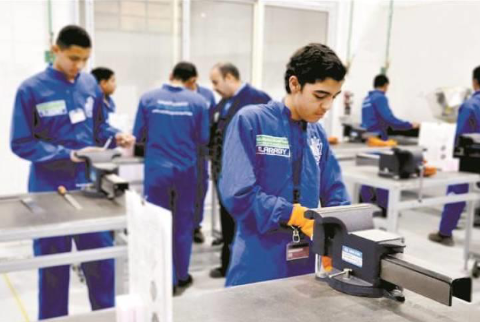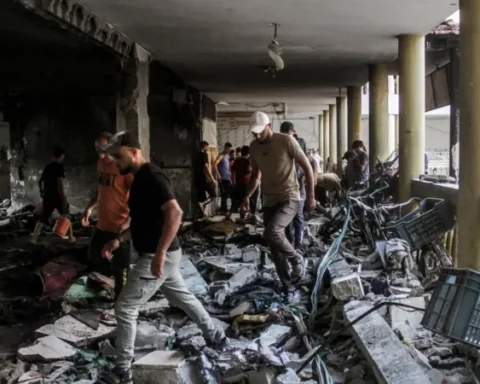Saturday, November 21, 2020
Press Release
———————————————–
The Electoral Observatory of the Egyptian Coalition for Human Rights and Development in collaboration with the Forum for Development and Human Rights Dialogue issued a study on Saturday entitled ” Reading the General Trends of Voting for the Second Phase Voting of the 2020 Parliamentary Elections”.
The study drew attention to the fact that in a (complimentary) step in line with the timetable announced by the National Electoral Commission, Egypt completed the preliminary electoral process for the second phase of the 2020 parliamentary elections, which included the procedure of voting competitiveness in the number (13) governorates representing the sectors of Cairo, central delta, Ash Sharqiya and Western Delta with a total of (72) constituencies allocated to it (142) seats in the electoral list system and (141) seats in the individual system, which is the electoral process that is expected by all.
The study made several important observations and readings regarding the general trends of the second phase vote, such as:
- The turnout in the second phase of the 2020 parliamentary elections (29.5%) was (9,289,199) voters out of a total of (31,480,127) voters.
- Of the 72 districts in the second phase, the elections were decided by winning in the number of (20) constituencies divided between (4) governorates by (27.8%).
- Full re-run takes place on the seats of (47) constituencies divided between (12) governorates by (65.3%) while (5) constituencies remain to decide part of their seats by winning while keeping another part of the re-election divided between (two governorates) by (6.9%).
- At the level of the seats allocated to the individual system, which are (141) seats representing (24.8%) of the total seats in the Parliament, the first round of the second phase was decided by (41) seats with (29.1%) of the stage seats, the largest number of which was in favour of Cairo Governorate with (24) seats followed by al-Qalyoubia with (15) seats, Port Said with (1) and with South Sinai (1) while the rest (100) seats (70.9%) came the largest number of them in the governorates of Dakahlia and Ash Sharqiya with (21) seats in each governorate followed by Gharbiya with (14), Manufiya with ( 11) and Kafr Al-Sheikh with (10).
- At the political level, these seats were divided among (4) major forces leach by (with a wide margin) the Nation’s Future Party, which held (34) seats that constituted (82.9%) of the total seats followed by the Independents Party with (4) seats and then the Republican People’s Party with (2) and Wafd Party with (1) in a numerical pattern indicating the continued partisan dominance over electoral competitiveness, which enabled it to obtain a total number of (37) seats against (4) for independents.
- Concerning the rest of the run-off, and given the results of the first round of voting from the second stage, we find that of the (141) seats allocated to individual voting went to the run-off with (200) candidates competing for (100) seats, the largest number of whom were in the (Gharbiya – Dakahlia) governorates with a total of (42) candidates in each governorate dedicated to (21) parliamentary seats followed by Al-Gharbia (28), Manufiya (22) and Kafr Al-Sheikh (20). While the smallest number of candidates running for re-election was in the governorates (Qalyubia – Port Said – South Sinai) were 2 candidates in each governorate.
- The replay trends also showed a very hot competitive and conflicting situation between independents on the one hand and representatives of political parties on the other, where the return reached (101) independent candidates against (99) party candidates divided between (11) political parties.
- Concerning the political analysis of the results of the list system, the national list dominates the scene, as despite those challenges that gave competitors votes and the crowding (not objective) and also caused a record-high percentage of votes (unprecedented) reached the failure and fall of (the national list) in Damietta governorate with 110,431 votes in front of the list (Sons of Egypt) which achieved (128,141) votes in a behaviour similar to what was achieved in the first stage in Luxor Governorate. The National List managed to settle the two confrontations in its favour, to win (142) seats in that stage, completing the same success that was achieved in its favour from the first stage in which it won (142) seats so that the National List won all the seats allocated to the election in the list system, and its total is (284) seats.
- The (Nation’s Future Party) dominated the absolute majority of the number of seats on the lists at that stage with a total of (72) where it won in the first constituency (central delta) with (53) seats and the third (East Delta) with (19) seats leaving (70) seats; (11) of which the independents, while the remaining share was distributed among (11) political organizations provided by the Republican People’s Party with (13) seats, then Wafd Party with (11) seats and Homeland Defenders Party (9) and Modern Egypt Party (8) and then lower quotas in favour of the rest of the forces and political currents below (national list).
- Concerning women in the electoral scene, they are limited and disturbing. Women candidates on the individual system have failed to reap their benefits or win any seat among the group that was decided from the first round, but women were not able to compete on the seats on which the run-off takes place except for (4) female candidates belonging to two constituencies (Zagazig – Minya Al Qamh) in one governorate (Ash Sharqia), which are far fewer results than those who achieved in the first stage in which MP Nashwa al-Deeb won the first round in addition to the arrival of (6) candidates for the run-off belonging to the governorates (Alexandria – El Beheira) which made the total to what was reached for the benefit of women in that electoral process collected win (one) and reaching the runoff rounds with (10) female candidates belonging to (3) governorates while the women completely exited the electoral scene in (23) governorates.
- Concerning Christians, the first stage was limited to the arrival of (7) candidates for the run-off, while the second stage, witnessed the candidacy of (72) Christians. A great achievement was achieved with the victory of (2) candidates from the first round without re-running; one of them ran in a single-seat constituency (Sahel) and yet he managed to win directly while the second won in a multi-seat constituency (Ain Shams) although the most prominent negative feature in this scene is the absence of any additional candidate for the run-off run by (200) candidates in an electoral behaviour that needs review and study, especially in light of the decline in the rates and percentages of the presence of Coptic candidates on the lists of political parties, which were limited to (9) candidates belonging to (5) parties, while the remaining (63) candidates were nominated as independents.
- By analyzing the professions and measuring their actual presence ratios, we find that the most prominent (profession) among them was the membership of the 2016 Council (if it may be considered a job) with several (42) competitors in addition to (5) MPs from the oldest parliaments as confirming the experience and skill in parliamentary practice enhances the ability of parliament to act effectively from the first day of its convening, followed by in the importance (and number) of police and security experiences with (19) candidates in addition to (3) candidates of former armed forces men.
- Businessmen and economists remain a great ability and influence on parliamentary work with a total of (48) candidates distributed on (5) job names led by businessmen with (15) candidates, managers and partners in economic activity with (13), import and export (8) and heads of boards of directors (8) and vice chairman of the board (4), which ensures efficiency for economic discussions and policies and main directions of development and investment programs.
- The traditional and main professions in the mentality of the association remained influential in the run-off, especially lawyers (8) candidates, doctors (7), teachers (6), journalists (3), academics (3) and engineers (2) to ensure the effective presence of middle-class elements and social justice and fair pay issues and equal distribution of the burdens and requirements of economic reform.
- With the continuing controversy over the law of reconciliation in building violations and the associated views and perceptions of application in addition to the emergence of the construction sector as one of the locomotives of development and considering the right to adequate housing as one of the main challenges occupying the political leadership, it was natural that the influential and clear presence of representatives of that job sector continued with (9) candidates in the continuation of the same success achieved in the first phase through which there were (14) candidates representing the contracting sector.








